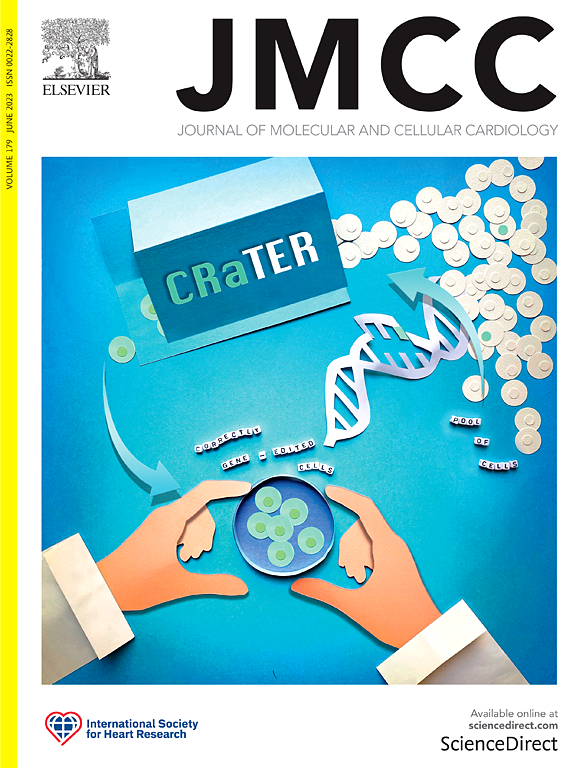A novel SCN3B in-frame codon deletion in a Brugada syndrome patient: Implications for disrupted NaV1.5 function
IF 4.9
2区 医学
Q1 CARDIAC & CARDIOVASCULAR SYSTEMS
引用次数: 0
Abstract
Introduction
Brugada Syndrome (BrS) is an inherited arrhythmia syndrome characterised by ST-segment elevation in the right precordial ECG leads and is associated with an increased risk of sudden cardiac death. We identify and characterise a novel SCN3B variant encoding the regulatory β3-subunit of the cardiac voltage-gated sodium channel, NaV1.5.
Methods and results
A 54-year-old Caucasian male presented with palpitations and dizziness. An ECG identified a spontaneous type 1 BrS pattern and review of his medical records revealed a prior type 1 BrS ECG. Next generation sequencing of a BrS risk panel of genes identified a novel SCN3B deletion (c. c412–414, p.T138Del) yielding a single amino acid deletion. No other pathogenic variants were identified. Using site-directed mutagenesis we made the β3-ΔT138 variant and examined structural and functional effects in a heterologous system. Computational predictions together with circular dichroism spectroscopy showed highly localised structural perturbations with minimal effect on the gross protein architecture. Biotinylation, co-immunoprecipitation and surface cross-linking experiments identified normal β3 surface expression and interaction with NaV1.5. Electrophysiological analysis identified reduced peak current and channel availability. Additionally, an accelerated fast inactivation was observed only in the presence of both wild-type and ΔT138 β3-subunits, reflecting the heterozygous individual. These effects are consistent with a loss-of-function phenotype.
Conclusion
A novel BrS associated SCN3B deletion introduced minimally disruptive structural perturbations to the regulatory β3-subunit of NaV1.5, yet exerted significant electrophysiological effects. This variant highlights nuances of the NaV1.5-β3 interaction and its role in maintaining normal cardiac excitability.

Brugada综合征患者框架内新的SCN3B密码子缺失:对NaV1.5功能破坏的影响
Brugada综合征(BrS)是一种遗传性心律失常综合征,其特征为右心前心电图导联st段抬高,与心源性猝死风险增加相关。我们鉴定并鉴定了一种新的SCN3B变体,该变体编码心脏电压门控钠通道的调节β3亚基NaV1.5。方法与结果:男性54岁,白种人,以心悸、头晕为主。心电图显示自发性1型BrS模式,回顾其医疗记录显示先前的1型BrS心电图。BrS基因风险面板的下一代测序鉴定出一种新的SCN3B缺失(c. c412-414, p.T138Del),产生单个氨基酸缺失。未发现其他致病变异。利用定点诱变技术制备了β3-ΔT138突变体,并在异源系统中检测了其结构和功能效应。计算预测和圆二色光谱显示高度局部的结构扰动对总蛋白质结构的影响最小。生物素化、共免疫沉淀和表面交联实验鉴定了正常β3表面表达和与NaV1.5的相互作用。电生理分析发现峰值电流和通道可用性降低。此外,仅在野生型和ΔT138 β3亚基同时存在时观察到加速的快速失活,反映了杂合个体。这些影响与功能丧失表型一致。结论:一种新的BrS相关的SCN3B缺失对NaV1.5的调节β3-亚基造成了最小破坏性的结构扰动,但却产生了显著的电生理效应。这种变异突出了NaV1.5-β3相互作用的细微差别及其在维持正常心脏兴奋性中的作用。
本文章由计算机程序翻译,如有差异,请以英文原文为准。
求助全文
约1分钟内获得全文
求助全文
来源期刊
CiteScore
10.70
自引率
0.00%
发文量
171
审稿时长
42 days
期刊介绍:
The Journal of Molecular and Cellular Cardiology publishes work advancing knowledge of the mechanisms responsible for both normal and diseased cardiovascular function. To this end papers are published in all relevant areas. These include (but are not limited to): structural biology; genetics; proteomics; morphology; stem cells; molecular biology; metabolism; biophysics; bioengineering; computational modeling and systems analysis; electrophysiology; pharmacology and physiology. Papers are encouraged with both basic and translational approaches. The journal is directed not only to basic scientists but also to clinical cardiologists who wish to follow the rapidly advancing frontiers of basic knowledge of the heart and circulation.

 求助内容:
求助内容: 应助结果提醒方式:
应助结果提醒方式:


